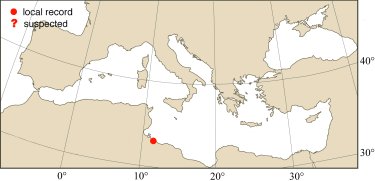
|
Relevant synonyms
Misidentification
Meristic formula
|
|
| photo : Jamila Ben Souissi |
|
SHORT
DESCRIPTION
color :
dorsal surface bluish with grayish to silvery white belly. Pectoral fin dark gray to black, its outer half with an oblique light bar centrally located. Dorsal fin not pigmented; anal and caudal fins dusky. |
DISTINGUISHING CHARACTERISTICS
BIOLOGY / ECOLOGY
habitat :
epipelagic, off-shore species. |
|
1st
MEDITERRANEAN RECORD
|

|
|
DISTRIBUTION
|
ESTABLISHMENT SUCCESS
speculated reasons for success :
|
|
|
MODE OF
INTRODUCTION |
IMPORTANCE TO
HUMANS |
|
KEY
REFERENCES
|